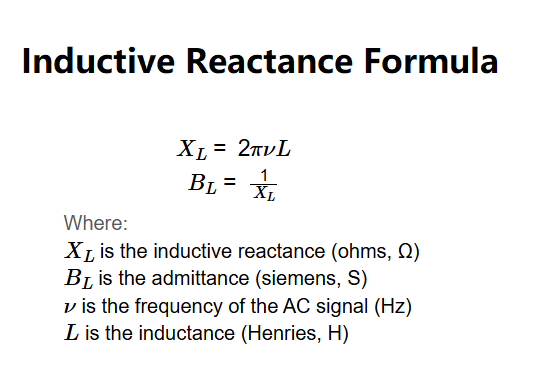1. What is an Inductive Reactance Calculator?
Definition: This calculator computes the inductive reactance (\( X_L \)) and admittance (\( B_L \)) of an inductor in an AC circuit, which describe the opposition to current flow and the ease of current flow, respectively.
Purpose: It is used in electrical engineering to design AC circuits, filters, and resonant circuits, such as in radios, transformers, and power systems.
2. How Does the Calculator Work?
The inductive reactance and admittance are calculated using:
\( X_L = 2 \pi \nu L \)
\( B_L = \frac{1}{X_L} \)
Where:
- \( X_L \) is the inductive reactance (ohms, Ω)
- \( B_L \) is the admittance (siemens, S)
- \( \nu \) is the frequency of the AC signal (Hz)
- \( L \) is the inductance (Henries, H)
Steps:
- Enter the frequency (\( \nu \)) and select a unit (Hz, kHz, MHz)
- Enter the inductance (\( L \)) and select a unit (nH, µH, mH, H)
- Convert frequency to Hz and inductance to Henries
- Calculate the inductive reactance using \( X_L = 2 \pi \nu L \)
- Calculate the admittance using \( B_L = \frac{1}{X_L} \)
- Convert \( X_L \) to mΩ, Ω, kΩ, and MΩ
- Convert \( B_L \) to µS, mS, S, kS, and MS
Display format:
- If a value is > 10000 or < 0.0001 (and not zero), use scientific notation (e.g., \( 1.23456e-3 \))
- Otherwise, display with 5 decimal places
3. Importance of Inductive Reactance Calculation
Details: Inductive reactance is crucial for understanding how inductors behave in AC circuits. It increases with frequency, affecting impedance in filters, transformers, and resonant circuits used in electronics and power systems.
4. Using the Calculator
Tips: Input positive values for frequency and inductance. The calculator handles unit conversions automatically, so select the appropriate units for your values.
Examples:
- Inductor in a radio circuit: \( \nu = 1 \, \text{MHz} \), \( L = 100 \, \text{µH} \):
- Convert: \( 1 \, \text{MHz} = 1 \times 10^6 \, \text{Hz} \), \( 100 \, \text{µH} = 100 \times 10^{-6} \, \text{H} \)
- \( X_L = 2 \pi \times 10^6 \times 100 \times 10^{-6} = 628.31853 \, \text{Ω} \)
- Conversions: \( 628318.53072 \, \text{mΩ} \), \( 0.62832 \, \text{kΩ} \), \( 0.00063 \, \text{MΩ} \)
- \( B_L = \frac{1}{628.31853} = 0.00159 \, \text{S} \)
- Conversions: \( 1591.54943 \, \text{µS} \), \( 1.59155 \, \text{mS} \), \( 0.00000 \, \text{kS} \), \( 0.00000 \, \text{MS} \)
- Power system inductor: \( \nu = 50 \, \text{Hz} \), \( L = 1 \, \text{H} \):
- \( X_L = 2 \pi \times 50 \times 1 = 314.15927 \, \text{Ω} \)
- Conversions: \( 314159.26536 \, \text{mΩ} \), \( 0.31416 \, \text{kΩ} \), \( 0.00031 \, \text{MΩ} \)
- \( B_L = \frac{1}{314.15927} = 0.00318 \, \text{S} \)
- Conversions: \( 3183.09886 \, \text{µS} \), \( 3.18310 \, \text{mS} \), \( 0.00000 \, \text{kS} \), \( 0.00000 \, \text{MS} \)
- High-frequency circuit: \( \nu = 10 \, \text{kHz} \), \( L = 1 \, \text{mH} \):
- Convert: \( 10 \, \text{kHz} = 10 \times 10^3 \, \text{Hz} \), \( 1 \, \text{mH} = 1 \times 10^{-3} \, \text{H} \)
- \( X_L = 2 \pi \times 10 \times 10^3 \times 1 \times 10^{-3} = 62.83185 \, \text{Ω} \)
- Conversions: \( 62831.85307 \, \text{mΩ} \), \( 0.06283 \, \text{kΩ} \), \( 0.00006 \, \text{MΩ} \)
- \( B_L = \frac{1}{62.83185} = 0.01592 \, \text{S} \)
- Conversions: \( 15915.49431 \, \text{µS} \), \( 15.91549 \, \text{mS} \), \( 0.00002 \, \text{kS} \), \( 0.00000 \, \text{MS} \)
5. Frequently Asked Questions (FAQ)
Q: What is inductive reactance?
A: Inductive reactance (\( X_L \)) is the opposition an inductor offers to alternating current, increasing with frequency and inductance.
Q: What is admittance?
A: Admittance (\( B_L \)) is the inverse of reactance, measuring how easily current flows through the inductor in an AC circuit.
Q: Why does inductive reactance depend on frequency?
A: The changing magnetic field in an inductor induces a voltage opposing the current change, and this effect is stronger at higher frequencies.
Inductive Reactance Calculator© - All Rights Reserved 2025
 Home
Home
 Back
Back
